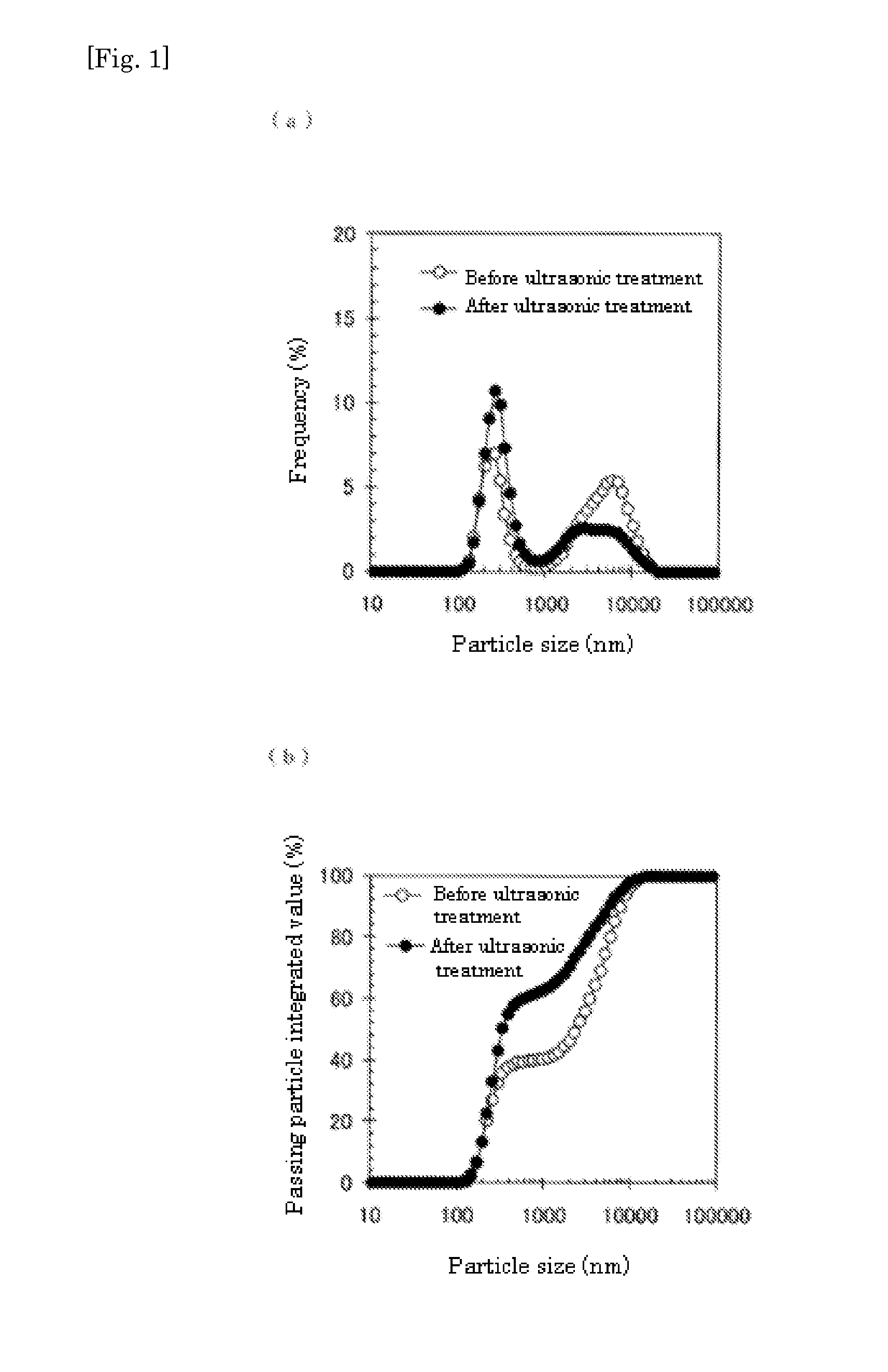Liquid food composition
- Summary
- Abstract
- Description
- Claims
- Application Information
AI Technical Summary
Benefits of technology
Problems solved by technology
Method used
Image
Examples
reference example 1
[0160]To 400 ml distilled water, 2.5 g of sodium alginate (KIMICAALGIN IL-2: manufactured by KIMICA corporation) was added to prepare 0.5 wt % aqueous sodium alginate solution. Next, 1.15 g of calcium carbonate and 0.75 g of magnesium carbonate were mixed to the aqueous sodium alginate solution. The mixture was cooled to room temperature, and then added with distilled water to make the volume 500 ml. A soft bag (R1420H: manufactured by Meiwa Pax Co., Ltd.) was filled with 200 g of the prepared liquid food composition, and the whole was sterilized (121° C., 20 minutes) in an autoclave sterilizer.
[0161]The prepared product was liquid and had a pH of 9.9 and a viscosity of 10 cP. Ascertaining the semi-solidification in an acidic condition, the prepared product was semi-solidified in an artificial gastric juice and gave a solid residue on a nylon screen. Even after standing storage (25° C.) for a month, the prepared product was not changed in the pH and viscosity and also in the degree ...
example 1
[0163]Based on the formulation described in Table 1, a liquid food composition containing 0.5 wt % sodium alginate was prepared.
TABLE 1Amount AddedComparativeComparativeComponentExample 1Example 1Example 2Sodium alginate0.5g0.5g0.5gDextrin12.2g12.2g12.2gSoybean protein4.3g4.3g—Sodium caseinate——4.3gFat (including emulsifier)3.4g3.4g3.4gCalcium carbonate230mg—230mgCalcium dihydrogen phosphate—580mg—Magnesium carbonate150mg—150mgMagnesium sulfate—420mg—Other minerals1330mg1330mg1330mgVitamins62mg62mg62mgDistilled waterBalanceBalanceBalanceTotal100ml100ml100mlpH 6.7— 6.8Viscosity110—110Generation frequency of solidNoneGelatedNoneOccurrence degree of componentA / **)Bseparation *)*) A: Component separation was not occurredB: Component separation was occurred**)Evaluation was impossible due to gelation
[0164]To 650 ml of distilled water, 5 g of sodium alginate was added. Next, a dextrin powder and a soybean protein powder (manufactured by Fuji Oil Co., Ltd.) were added. A fat (containing ...
example 2
[0180]In a similar manner to that in Example 1, liquid food compositions (1) without sodium alginate, (2) containing 0.3 wt % sodium alginate, (3) containing 0.5 wt % sodium alginate, (4) containing 1.0 wt % sodium alginate, and (5) containing 1.5 wt % sodium alginate were prepared. The sodium alginates used were “KIMICAALGIN IL-2: manufactured by KIMICA corporation” in (2) to (4) and “KIMICAALGIN IL-1: manufactured by KIMICA corporation” in (5), while the protein source used was a soybean protein.
TABLE 2(1)(2)(3)(4)(5)Concentration of sodium alginateWithout0.3 wt0.5 wt1.0 wt1.5 wtaddition% IL2% IL2% IL2% IL1pH6.86.86.77.37.3Viscosity3580110195190Degree of semi-CBAAAsolidification*)*)C: Not semi-solidifiedB: A semi-solidified product was observed on a nylon screen.A: Most was semi-solidified to give a residue on a nylon screen.
[0181]Each food composition obtained was liquid.
[0182]Ascertaining the semi-solidification in an acidic condition, (1) the composition without sodium alginate...
PUM
| Property | Measurement | Unit |
|---|---|---|
| Temperature | aaaaa | aaaaa |
| Fraction | aaaaa | aaaaa |
| Fraction | aaaaa | aaaaa |
Abstract
Description
Claims
Application Information
 Login to View More
Login to View More - R&D
- Intellectual Property
- Life Sciences
- Materials
- Tech Scout
- Unparalleled Data Quality
- Higher Quality Content
- 60% Fewer Hallucinations
Browse by: Latest US Patents, China's latest patents, Technical Efficacy Thesaurus, Application Domain, Technology Topic, Popular Technical Reports.
© 2025 PatSnap. All rights reserved.Legal|Privacy policy|Modern Slavery Act Transparency Statement|Sitemap|About US| Contact US: help@patsnap.com



